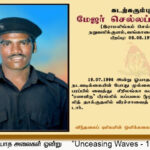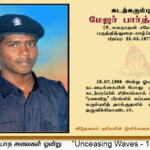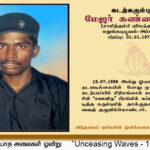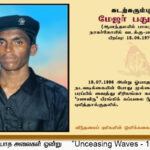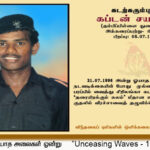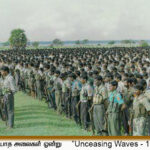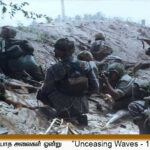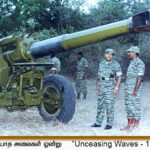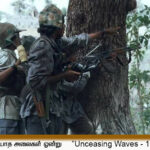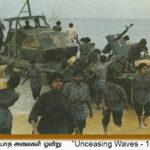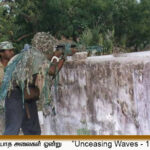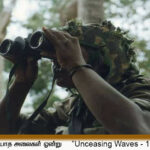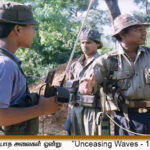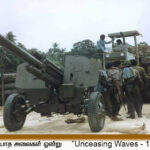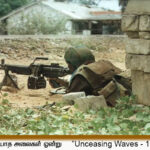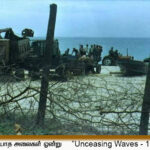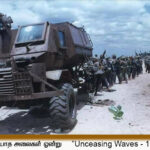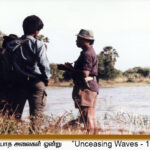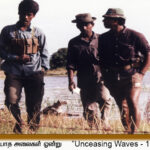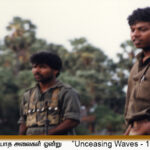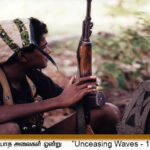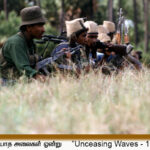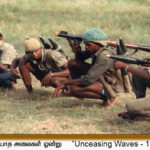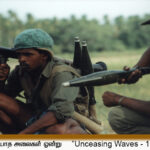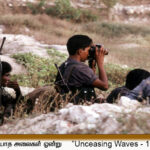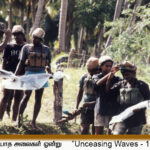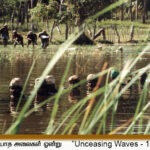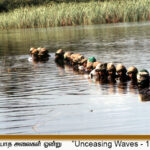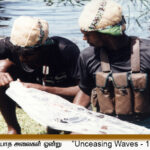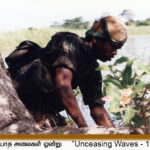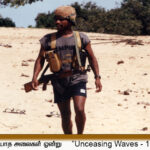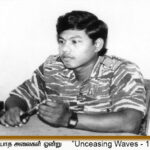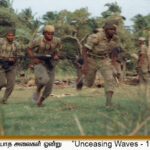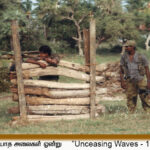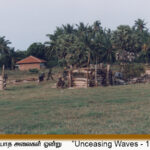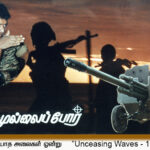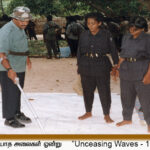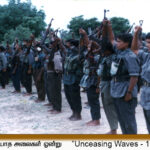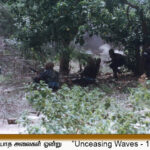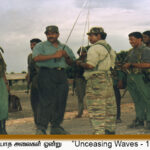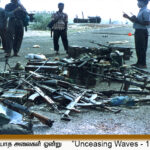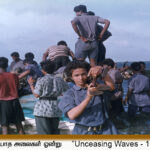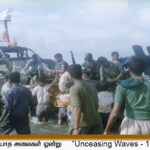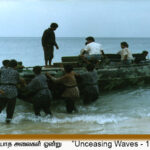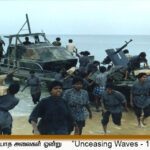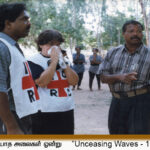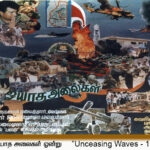

”Unceasing Waves – 1”- The great battle of Mullai
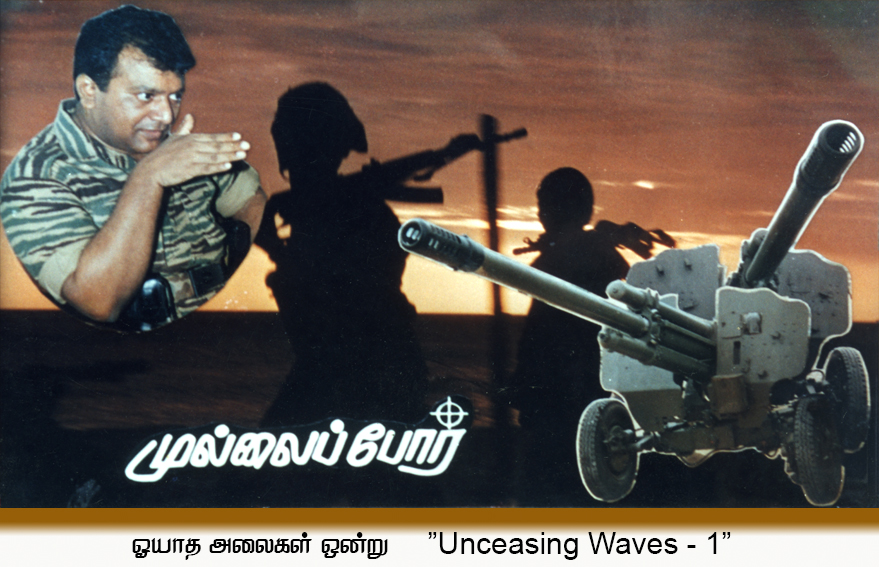
”Unceasing Waves” – an operation named by the LTTE, an operation where Mullaitheevu Army Camp was attacked and defeated by LTTE. The city of Mullaitivu was recaptured.
The timing of the attack was significant. Jaffna, which then was considered as a stronghold of the LTTE and the epicenter of the struggle, had been completely taken over by Sinhala forces. A time where everyone asked the LTTE what is the next step. “The LTTE has lost 80 % of their fighters. And there is only 20 % back”, Sinhala General Ratwatha said.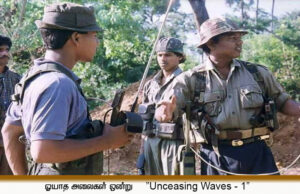
(This Ratwatha wanted to jump straight to the fourth stage in the Sri Lankan military state without going to the Brigadier, Major General, and Lieutenant General. Fortunately the rank of Field Marshal was not given to him.)
Massive attack carried out at the said time. It was a time when the Tamil people were distrustful of the struggle. It was time where Tamil people thought Jaffna was out of the hand of Tamil people. “Unceasing Waves” was a battle where Mullaitheevu Base was a stronghold with a force of about two thousand fighters and two artillery pieces. A base that maintained maritime and air communications and with no direct land contact with other areas. The base was located on the deep coast of Mullaitheevu and was well connected by sea. In case of any emergency Trincomalee was within an hour’s voyage by sea.
All offensive drills on the base were conducted in the vicinity of the Poonakary base. The story spread easily among the people that Poonakary was going to be attacked. Even for the fighters thought Poonakary was presumed to be the target.
Suddenly the teams changed overnight and the plan was explained. The teams were changed and hidden without people knowing.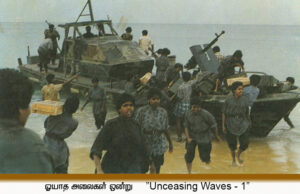
As planned, on the morning of the eighteenth a strong attack was made on the barracks. The ”Dora” boats had arrived from the port of Thirumalai on the assumption that maritime aid would be available within half an hour of the attack. The Sea Tigers of LTTE watched the boats and attacked them. The Sinhala forces fought heavily to land the boats but the Sea Tigers also tried hard to stop them from landing on Mullaitheevu at any cost. There was heavy fighting on the ground as well.
The warship ”Ranaviru” sank in the sea due to the attack of the Black Tiger boats. The Black Tigers’ attack on an epic Turkicov cell with 600 troops and lost the goal. The cell and the troops ecaped. Attempts were also made to land troops in the air. Here one of the helicopters was shot down.
After 3 days of heavy fighting more than a thousand troops landed by air and sea in the village of Alampil, outside Mullaitheevu. The LTTE fiercely opposed their move towards Mullaitheevu. Heavy fighting took place outside. The Air Force and Navy used all their strength. The Mullaitheevu barracks have been completely captured. Two artillery pieces and a large quantity of weapons were captured from the Sri Lankan military. Now the whole focus of the LTTE turned to confronting the landed troops. Unable to withstand the hard counterattack, the landed troops began to flee.
Where to run?
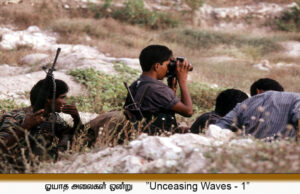 You had to run by sea again. Again a military boat came. The soldiers put down their weapons and fled out to the boat. The rest of the soldiers ran away when the boat did not have time to take all soldiers with it.
You had to run by sea again. Again a military boat came. The soldiers put down their weapons and fled out to the boat. The rest of the soldiers ran away when the boat did not have time to take all soldiers with it.
Some of the survivors wandered into the forrest and somehow made their way to the Kokkutoduva barracks. It was through them that many of the lies of the Sinhalese came out. Ratwatte had said: The army forces had destroyed both artilleries. But the survivors said they had witnessed the LTTE dragging the artillery. They also told about the number of soldiers who died.
More than 1300 soldiers were killed in the attack. The LTTE handed over 800 bodies but the Sri Lankan government did not accept them. Many bodies were burned. Those who go to the Vanni can still find those places. Many of the soldiers who have been declared missing by the Sinhala government to date are among those who have been burned. (In the “Unceasing Waves” 2 and 3, many bodies were also denied by the Sri Lankan government and were cremated by the LTTE.)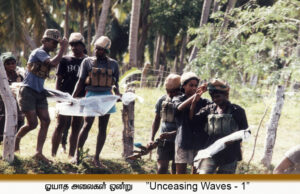
This attack was the undeniable leap of the struggle. The Tamil fighters received the first two artilleries. From that day there was a gradual development in the LTTE. A Sri Lankan barrack was destroyed in Vanni, and the most important city, Mullaitheevu, was recaptured. The incredible growth of the Sea Tigers began here. Only then, the modern technology and weapons become available to the movement. Only then, the ability to defeat any battle and the ability to attack and capture any barracks was improved. Everything from the victory of Jayasikuru to the recapturing of Elephant Pass was obtained within Mullaitheevu. Wartime diplomatic missions were also within Mullaitheevu. Balasingham’s discharge was also within it.
Today ‘Kilinochchi’ is seen as the center of the struggle. It is not the center of the struggle but the center of the meetings. Everything referred to Vanni, is Mullaitheevu in reality.
Mullaitheevu has been full of bodies twice the last ten years. The first case was during the “Unceasing Waves” operation. The other was during the tsunami disaster.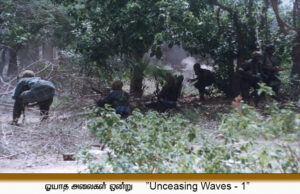
Bandara Vanniyan has a history of attacking British troops on the same Mullaitheevu and capturing artillery there. The operation “Unceasing Waves” continues this. Mullaitheevu is an undefeated city. Its existence is the existence of the Tamil forces. Any other city can be captured. Mullaitheevu is a city not to be missed.
A series of activities took place in the name of “Unceasing Waves”. The LTTE carried out a series of operations under the same name “Unceasing Waves”. “Unceasing Waves – 4’ was the operation to finally capture the city of Jaffna.
The LTTE was dragging an artillery captured in Mullaitheevu towards Puthukkudiyiruppu. Some people have noticed the artillery when it was parked in the middle of the forest for short time. It was early morning time. The crowd gradually began to increase in the city. The place begins to weed out that someone has seen an artillery in the forrest and some people riding bicycles to tell others what they saw. One or two fighters standing with the artillery could not control the people or want to control them.
Fighters with captured artillery
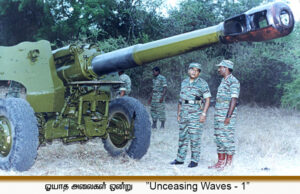 Some of the people came back with the garlands and put it on the artillery. The evening starts with the trumpet and dance. People did arrive with coconuts too, as a tradition of Tamil people. Coconuts began to break in front of the artillery and a festival began there. The fighters dragged the artillery and disappeared again before the Iyer (Temple priest) came.
Some of the people came back with the garlands and put it on the artillery. The evening starts with the trumpet and dance. People did arrive with coconuts too, as a tradition of Tamil people. Coconuts began to break in front of the artillery and a festival began there. The fighters dragged the artillery and disappeared again before the Iyer (Temple priest) came.
“Attack”
On the night of July 17, 1996 and early on the morning of the 18th the LTTE launched an attack on the base from the front lines. The Sri Lankan troops were unable to receive assistance when they was not in contact with other barracks. Within three days, the barracks of Sri Lankan Army had completely fallen to the LTTE. The LTTE captured all the weapons there. This was the first time in the history of the Eelam War that an artillery came into the hands of the LTTE. Two 122mm artillery placed at the Mullaitheevu base were captured by the LTTE.
“Landing and Battle”
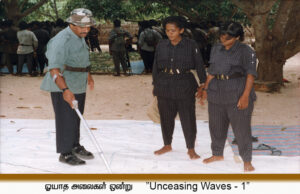 When the Mullaitheevu base was attacked by the LTTE, a landing was made by the Sri Lankan government forces to protect the troops and the base. The Sri Lankan government forces made a major landing by sea in the village of Alampil, three miles south of the site of the attack. The government forces named the landing as “Trivida Pakara”, which was carried out by the three forces of the Sri Lankan government.
When the Mullaitheevu base was attacked by the LTTE, a landing was made by the Sri Lankan government forces to protect the troops and the base. The Sri Lankan government forces made a major landing by sea in the village of Alampil, three miles south of the site of the attack. The government forces named the landing as “Trivida Pakara”, which was carried out by the three forces of the Sri Lankan government.
LTTE cadres fought against the ground troops. The Tigers had prevented the landing of Sri Lankan force from advancing and finally won a complete victory. The government forces recaptured most of the landing forces and the ‘Unceasing Waves – 1’ operation ended.
In the battle, there was an attack on a Sri Lankan ship called “Ranaviru”. This attack was handled by Black Tigers. And following 7 fighters became heroes:
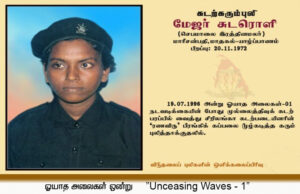 Major Kannapiran
Major Kannapiran
Major Sellapilla
Major Parthiban
Major Mithupalan
Major Pathuman
Major Sudaroli
Captain Sayantan
They captured the Mullaitheevu district and took full control of the camp.
“Loss details and media censorship”
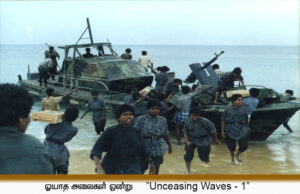 According to LTTE sources more than 1200 soldiers were killed in the attack.
According to LTTE sources more than 1200 soldiers were killed in the attack.
But the government denied it, saying only a handful of soldiers had been killed. General Anuruddha Ratwatte, the then Deputy Defense Minister and one who was promoted to General after the capture of the Jaffna Peninsula, said that none of the artillery had been captured by the LTTE.
Although the LTTE handed over hundreds of bodies to the government through the International Committee of the Red Cross, the government did not accept them. Instead they received only a few and denied that the others belonged to their military. The civilians and the LTTE in the Vanni set hundreds of bodies on fire. The bodies of up to 600 soldiers were burned together at a place called Kokka.
“Our heroic tribute to the 400 heroes who embraced heroism in the “Unceasing Waves” operation to rescue Mullaitheevu.”
Oyata Alaikal – 01 ”Mullai Victory Battle”
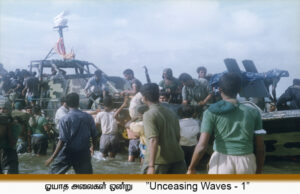 When the LTTE shifted its base from the Jaffna to the Vanni, the Sri Lankan government spread out the propaganda that the LTTE had been weakened and went back into the Vanni. But this thought ended with a successful torpedo explosion in the early hours of 18.07.1996 in the Mullaitheevu by the LTTE.
When the LTTE shifted its base from the Jaffna to the Vanni, the Sri Lankan government spread out the propaganda that the LTTE had been weakened and went back into the Vanni. But this thought ended with a successful torpedo explosion in the early hours of 18.07.1996 in the Mullaitheevu by the LTTE.
Named the operation “Unceasing Waves”, the LTTE’s attack was the first of its kind in the history of the LTTE’s “Unceasing Waves -1”.
The LTTE stronghold of Mullaitheevu was brought under complete control after a 30-hour LTTE offensive. The attack also marked another development of the LTTE.
The Sri Lankan Forces were prevented from landing by sea in Mullaitheevu as a sign that the LTTE had gained the strength to block the naval support of the Sri Lankan Navy.
The world also saw the LTTE gaining strength at sea to challenge the Sri Lankan Navy.
”Mullai Base”
 The Mullaitheevu base is located on the coast of the Mullaitheevu district in the Vanni region. Less than a dozen Sri Lankan soldiers were staying in a small tent outside of Mullaipattinam. Over time it expanded.
The Mullaitheevu base is located on the coast of the Mullaitheevu district in the Vanni region. Less than a dozen Sri Lankan soldiers were staying in a small tent outside of Mullaipattinam. Over time it expanded.
Following the LTTE’s siege of the area in 1990, the Sri Lankan forces set up a strong base there to rescue their troops in the name of “Operation SEA BREEZE”.
1992 – “Operation SATHBALA”
As the Sri Lankan force moved towards Manalaru, the forces were unable to move further and the forces soon retreated to the Mullai Base. The Mullai Base, which continued to expand, became a joint base during the operation “Unceasing Waves – 1” attack.
During “Unceasing Waves – 1” Mullaittivu Base deployed 1407 troops. The base was the 25th Brigade Joint Base at the time of the attack.
The site of the base was 2900 m long and had two rows of insulation, outer and inner. The length is 1500 m. Its outer perimeter was 8500 meters in circumference.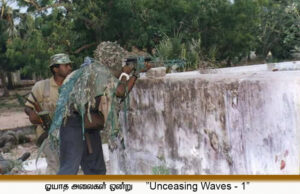
The base of the barracks was centered at Mullaipattinam and contained the main structures of the site such as artillery, motor launcher, brigade headquarters, battalion headquarters, telecommunication tower and landing platform.
The outer line was bounded on the east by the Indian Ocean, on the south by Raalkulam and vast plains, on the west by the Nanthi Sea, and on the north by Vedduvaikkal. This grounding was found to be very favorable for backup sorting.
The place was lined with high barracks of approximately 40 meters, with surveillance arrangements such as observation towers, and a high covering fence. The site had high-security arrangements such as barriers, mesh fields, and sound surveillance and night surveillance arrangements set up in several columns on the outside of the sand.
“Spying”
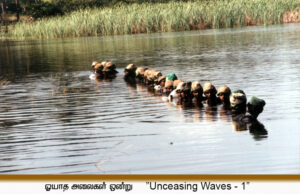 The site was subject to LTTE general spying. But after the LTTE’s base moved to the Vanni, intensive reconnaissance operations were launched under the coordination of a special commander under the command of the national leader. Extensive spying was carried out by sea and land. In the midst of great danger the spies spent the night in the base and learned the structure of the Mullai Base.
The site was subject to LTTE general spying. But after the LTTE’s base moved to the Vanni, intensive reconnaissance operations were launched under the coordination of a special commander under the command of the national leader. Extensive spying was carried out by sea and land. In the midst of great danger the spies spent the night in the base and learned the structure of the Mullai Base.
“Attack plan”
In the operation “Unceasing Waves – 01”, all operations were rehearsed in practice and laid out very carefully. For example, teams were moved within the killing zone of the outer perimeter of the opposing base to obtain time for movement.
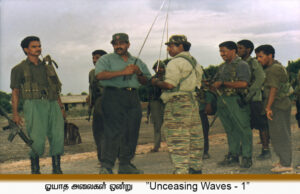 The attack plan consisted of the following steps.
The attack plan consisted of the following steps.
- Creating infiltration paths in the enemy’s outer perimeter.
- Teams infiltrating the path capture the outer line armor.
- Infiltration routes and entry lines with favorable paths in the captured backup line to search the area and bring the area between the outer protection line and the center of the site under control.
- Teams moving toward the center of the base as soon as the attack begins to control the center of the base.
- Teams infiltrating by sea and bring the beach under control and cut off maritime support for the site.
Apart from this the following works were also planned.
- Preventing ground support from being provided to the site from sandy terrain.
- Prevention of retreating troops from the base toward the desert area.
- Prevent landing and site strengthening in areas adjacent to the site.
In order to ensure complete success overall,
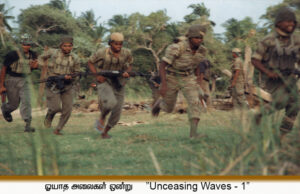 Accurate and detailed spying operation.
Accurate and detailed spying operation.- Comprehensive and detailed attack plan.
- Semi-conventional attack techniques that are bold and innovative.
- Detailed background arrangements.
- Extensive series of rehearsal exercises provided based on accurate information.
- Secret Backup.
- Cheat operations.
- Efficient use of indirect firearms by the enemy.
- Adequate Personnel, Armed Forces Allocation.
“Unceasing Waves – 01” attack planned.
“Attack”
Attack teams infiltrated their target areas as planned and took control of most of the site on the morning of the 18th. In particular, the coast was brought under complete LTTE control. Troops were barricaded inside the headquarters of the 6th Vijayabahu Brigade. The troops carried out attacks to bring the nearby coast under their control, but were all repulsed by the LTTE.
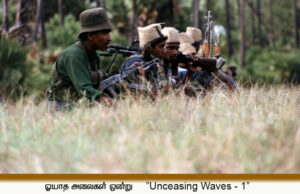 “Great resistance of the sea tigers”
“Great resistance of the sea tigers”
At the same time, all attempts by the Sri Lankan navy to reach the shores of the Mullai Base were thwarted by the LTTE. Faced with the strength of the Sri Lankan Navy and the aircraft of the Sri Lankan Air Force for 15 hours the LTTE fought bravely.
“The brave landing”
Sri Lankan forces carried out an aerial landing on the evening of the 18th in the Chilaw area, 3 km south of the Mullaitheevu Base, as a sea landing was not possible on the beach at the Mullaitheevu Base. The operation, named the Trivada Pakara, landed commandos in the first phase of the MI-17 helicopters, with the attack support of the Kibir and Bukhara bombers, MI-24 attack helicopters.
The aim of the troops was to carry out a maritime landing after creating a safe landing zone with the commandos. On the 18th the Tigers did not allow them to achieve that goal. In anticipation of such a landing, LTTE troops rounded up the landed commandos on the night of the 18th.
“The site came under complete control”
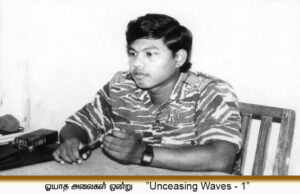 At the same time, on the evening of the 18th, all the troops were eliminated by the LTTE. LTTE came close to attack the troops inside the Mullaitheevu Base with heavy artillery fire and brought the barracks under the complete control of the LTTE.
At the same time, on the evening of the 18th, all the troops were eliminated by the LTTE. LTTE came close to attack the troops inside the Mullaitheevu Base with heavy artillery fire and brought the barracks under the complete control of the LTTE.
“Ranaviru drowned”
The Tigers did not allow the troops who landed in Chilavaththai on the 19th to be encouraged by sea. At around 4.30 pm that evening, sea tigers sank the Sangai 3 artillery boat Ranaviru, which was attempting to land. Then after an air landing was only possible for Sri Lankan forces. At the same time, the LTTE launched close attacks and shelling on the ground troops.
“MI-24 damaged”
On the 20th, the only hope of the Sri Lankan forces was to make an air landing possible. The danger, which came in the form of LTTE missiles, made it impossible for an air landing and damaged an MI-17 helicopter that had landed that day.
“Landing forces under tight LTTE siege”
 On the 21st, the Sri Lankan navy made a maritime landing after a heavy effort. Thus the troops were unable to break through the LTTE siege, despite being grounded and encouraged.
On the 21st, the Sri Lankan navy made a maritime landing after a heavy effort. Thus the troops were unable to break through the LTTE siege, despite being grounded and encouraged.
“Landing attempts in vain”
Attempts to land on the 22nd were not possible, but Sri Lankan forces continued their landing efforts. On the 23rd, a landing boat was damaged by a LTTE shelling. Another landing boat was damaged only a bit when a sea black tiger boat exploded before the collision. The landing was still not possible that day for the Sri Lankan troops.
“Recovered troops rescued great tragedy”
On the 25th, a maritime landing was possible, but the troops who broke through the LTTE siege could not advance an inch. And the troops that landed due to the LTTE shelling were suffering casualties.
The landing boat that had rescued the troops that landed on the 26th escaped from the LTTE shelling. The landing forces were rescued by the landing boat in the midst of great danger.
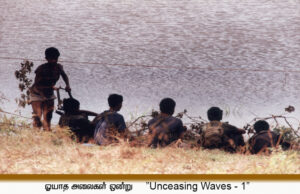 Lt. Colonel Busley Labir, who lead the ground forces at the front, was killed in the operation. Colonel Lawrence Fernando was wounded. More than 75 of the soldiers who landed were killed. More than 100 firearms thrown into the sea were recovered by the LTTE.
Lt. Colonel Busley Labir, who lead the ground forces at the front, was killed in the operation. Colonel Lawrence Fernando was wounded. More than 75 of the soldiers who landed were killed. More than 100 firearms thrown into the sea were recovered by the LTTE.
“More than 1,200 soldiers killed”
More than 1,200 soldiers were killed, including ground troops. Large quantities of ammunition, including two 122 mm artillery pieces and ammunition were captured by LTTE. Above all, the Tamils restored their traditional name of Mullaipattinam.
314 fighters, including seven sea black tigers, sacrificed their lives for this victory.
“Unceasing Waves”
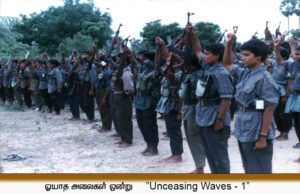 The successful launch of “Unceasing Waves – 01” signs the new evolution of the LTTE. This victory had many positive consequences for the LTTE. The people who were displaced to Vanni when the Sri Lankan forces invaded the Jaffna were refreshed by this victory.
The successful launch of “Unceasing Waves – 01” signs the new evolution of the LTTE. This victory had many positive consequences for the LTTE. The people who were displaced to Vanni when the Sri Lankan forces invaded the Jaffna were refreshed by this victory.
The illusion that the Tigers had been weakened was shattered. The “Unceasing Waves” started like this then rose to 02 and 03, and exposed the strength of the Tamils and the Liberation Tigers of Tamil Eelam (LTTE) to the enemy, and the international community.
The waves will not rest until our soil dawns.
– LTTE Research Center –
Click below for more articles
![]()
010. Oyatha Alaikal
046. Oyatha Alaikal MULLAI 01
